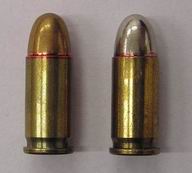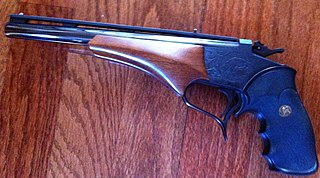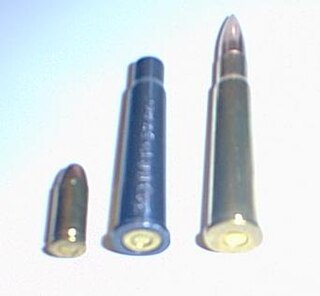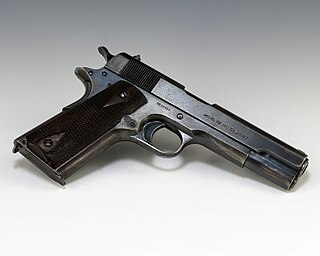Related Research Articles

A carbine is a long gun that has a barrel shortened from its original length. Most modern carbines are rifles that are compact versions of a longer rifle or are rifles chambered for less powerful cartridges.

A firearm is any type of gun designed to be readily carried and used by an individual. The term is legally defined further in different countries.

A revolver is a repeating handgun that has at least one barrel and uses a revolving cylinder containing multiple chambers for firing. Because most revolver models hold up to six rounds of cartridge before needing to reload, revolvers are also commonly called six shooters.

Flintlock is a general term for any firearm that uses a flint-striking ignition mechanism, the first of which appeared in Western Europe in the early 16th century. The term may also apply to a particular form of the mechanism itself, also known as the true flintlock, that was introduced in the early 17th century, and gradually replaced earlier firearm-ignition technologies, such as the matchlock, the wheellock, and the earlier flintlock mechanisms such as snaplock and snaphaunce.

A derringer is a small handgun that is neither a revolver nor a semi/fully automatic pistol. It is not to be confused with mini-revolvers or pocket pistols, although some later derringers were manufactured with the pepperbox configuration. The modern derringer is often multi-barreled, and is generally the smallest usable handgun of any given caliber and barrel length due to the lack of a moving action, which takes up more space behind the barrel. It is frequently used by women because it is easily concealable in a purse or a stocking.

The Beretta 950 is a semi-automatic pistol designed and manufactured by Beretta since 1952. It builds on a long line of small and compact pocket pistols manufactured by Beretta for self-defense. It was intended to be a very simple and reliable pocket pistol.

.32 ACP is a centerfire pistol cartridge. It is a semi-rimmed, straight-walled cartridge developed by firearms designer John Browning, initially for use in the FN M1900 semi-automatic pistol. It was introduced in 1899 by Fabrique Nationale, and is also known as the 7.65×17mmSR Browning or 7.65 mm Browning Short.

Personal defense weapons (PDWs) are a class of firearms intended for self-defense and security rather than warfare and infantry. Most PDWs fire a small-caliber, centerfire bottleneck cartridge resembling a scaled-down intermediate rifle cartridge, essentially making them an "in-between" hybrid between a submachine gun and a carbine.

Ethan Allen was a major American arms maker from Massachusetts. He is unrelated to the revolutionary Ethan Allen. His first firearm, the "Pocket rifle" was developed in 1836, and his first patent was granted in 1837.

In American English, a pocket pistol is any small, pocket-sized semi-automatic pistol, and is suitable for concealed carry in either a coat, jacket, or trouser pocket.

The Thompson/Center Contender is a break-action single-shot pistol or rifle that was introduced in 1967 by Thompson/Center Arms. It can be chambered in cartridges from .22 Long Rifle to .45-70 Government.

A caliber conversion sleeve or adapter sleeve is a device which can be used to non-permanently alter a firearm to allow it to fire a different cartridge than the one it was originally designed to fire. The different cartridge must be smaller in some dimensions than the original design cartridge, and since smaller cartridges are usually cheaper, the device allows less expensive fire practice.

The Model 1908 Vest Pocket is a compact, hammerless, striker-fired, semi-automatic single-action pistol. Manufactured by the Colt's Manufacturing Company from 1908 to 1948, it was marketed as a small concealable firearm which could be easily tucked into a vest pocket for unobtrusive carry. Designed by John Moses Browning, the Model 1908 followed Browning’s earlier European version, introduced by Fabrique Nationale de Herstal as the FN Model 1906. Both pistols were chambered for the Browning-invented .25 ACP cartridge.

The Grizzly Win Mag pistols were conceived, invented, designed, engineered and developed in the 1980s by the sole inventor, Perry Arnett, who licensed his patent for an interchangeable caliber semi-automatic pistol to L.A.R. Manufacturing Inc. Perry Arnett's designs were initially flawed and were improved upon by Heinz Augat. The L.A.R. Grizzly was the most powerful semi-automatic pistol ever commercially produced after the Desert Eagle.

A handgun is a short-barrelled gun, typically a firearm, that is designed to be usable with only one hand. It is distinguished from a long gun, which needs to be held by both hands and also braced against the shoulder to be used properly. The two most common types of handguns in modern times are revolvers and semi-automatic pistols, although other types such as derringers and machine pistols also see infrequent usage.

A pistol is a handgun, more specifically one with the chamber integral to its gun barrel, though in common usage the two terms are often used interchangeably. The English word was introduced in ca. 1570, when early handguns were produced in Europe, and is derived from the Middle French pistolet, meaning a small gun or knife. In colloquial usage, the word "pistol" is often used to describe any type of handgun, inclusive of revolvers and the pocket-sized derringers.

In firearms, the cylinder is the cylindrical, rotating part of a revolver containing multiple chambers, each of which is capable of holding a single cartridge. The cylinder rotates (revolves) around a central axis in the revolver's action to sequentially align each individual chamber with the barrel bore for repeated firing. Each time the gun is cocked, the cylinder indexes by one chamber. Serving the same function as a rotary magazine, the cylinder stores ammunitions within the revolver and allows it to fire multiple times before needing to reload.
The following are terms related to firearms and ammunition topics.

The family of Colt Pocket Percussion Revolvers evolved from the earlier commercial revolvers marketed by the Patent Arms Manufacturing Company of Paterson, N.J. The smaller versions of Colt's first revolvers are also called "Baby Patersons" by collectors and were produced first in .28 to .31 caliber, and later in .36 caliber, by means of rebating the frame and adding a "step" to the cylinder to increase diameter. The .31 caliber carried over into Samuel Colt's second venture in the arms trade in the form of the "Baby Dragoon"-a small revolver developed in 1847–48. The "Baby Dragoon" was in parallel development with Colt's other revolvers and, by 1850, it had evolved into the "Colt's Revolving Pocket Pistol" that collectors now name "The Pocket Model of 1849". It is a smaller brother of the more famous "Colt's Revolving Belt Pistol of Naval Caliber" introduced the same year and commonly designated by collectors as the "1851 Navy Model". In 1855 Colt introduced another pocket percussion revolver, the Colt 1855 "Sidehammer", designed alongside engineer Elisha K. Root.

The Colt New Service is a large frame, large caliber, double-action revolver made by Colt from 1898 until 1941. Made in various calibers, the .45 Colt version with a 5½" barrel, was adopted by the U.S. Armed Forces as the Model 1909.
References
- 1 2 Brodsky, Adam (December 12, 2008). "Take Two Bullets & Call Me In The Morning". New York Post .
- 1 2 Boyd, Bob (June 20, 2016). "Disabled But Not Defenseless". Shooting Illustrated. NRA. Retrieved July 7, 2016.
- 1 2 3 4 "Easy-to-Use 'Palm Pistol' Aimed at Elderly, Disabled". Fox News . December 5, 2008.
- ↑ Geller, Andy (December 9, 2008). "Arthritis Gun Backfires With Fda". New York Post .